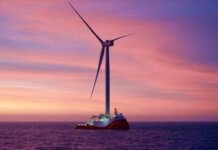The Ameren Transmission Co. of Illinois has completed and energized the Mark Twain Transmission Project, a 96-mile, 345 kV transmission line and substation in northeast Missouri. The line travels west from Palmyra to Kirksville, Mo., then north to the Iowa border.
The $267 million project is now providing improved energy grid reliability, increased transmission capacity and greater access to lower-cost energy, including renewable sources.
“The Mark Twain Transmission Project benefits are many,” says Shawn E. Schukar, chairman and president of ATXI. “In addition to making the energy grid more reliable and promoting renewable and affordable energy such as wind, it will meet energy needs not only for today, but well into the future.”
“The speed and efficiency with which this line was developed and constructed can be attributed to the ongoing collaboration and strong communication efforts we had with landowners, community representatives and Northeast Missouri Electric Power Cooperative,” Schukar adds. “Because of our focus on communication, our contract partners were able to quickly move forward on key construction phases, meet crucial deadlines and now energize this important infrastructure project that bolsters the energy grid.”
The Mark Twain Transmission Project was approved in 2011 by the Midcontinent Independent System Operator Inc. (MISO), a regional transmission organization. The project is part of a coordinated, multi-state group of transmission projects – known as Multi-Value Projects – being developed by transmission owners in MISO territory to improve and strengthen the regional energy grid. Other ATXI Multi-Value Projects include the Spoon River Project in Illinois, which was completed in February 2018, and the Illinois Rivers Project, with an anticipated in-service date of December 2020.





What a waste of money. In Iowa MidAmerican past and present CEOs have openly admitted that the entire cost to build wind turbines is paid through our taxes. Wind turbines “replace” no other power plants and require thousands of miles of excess transmission. It is the Averch-Johnson Effect. We may have 97,000 MW of wind capacity but we only actually utilize about 1/4 of that according to government sources.